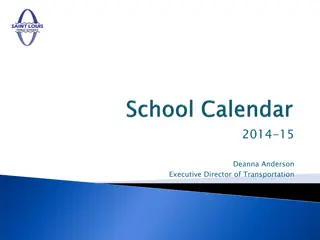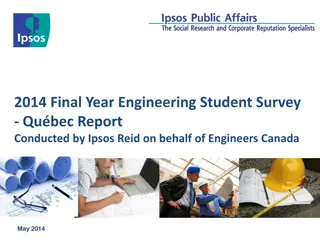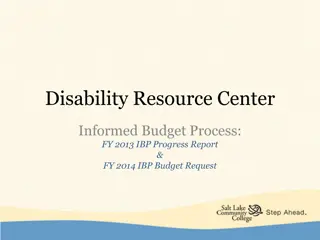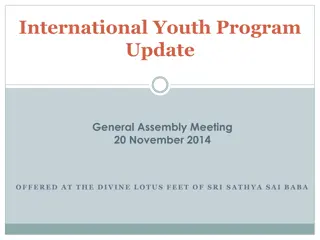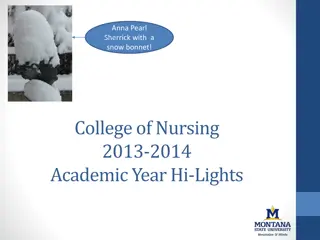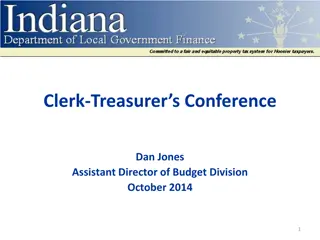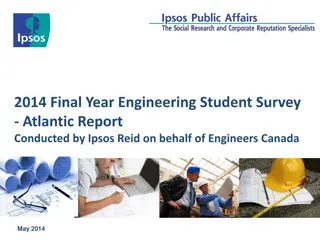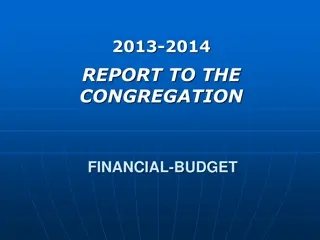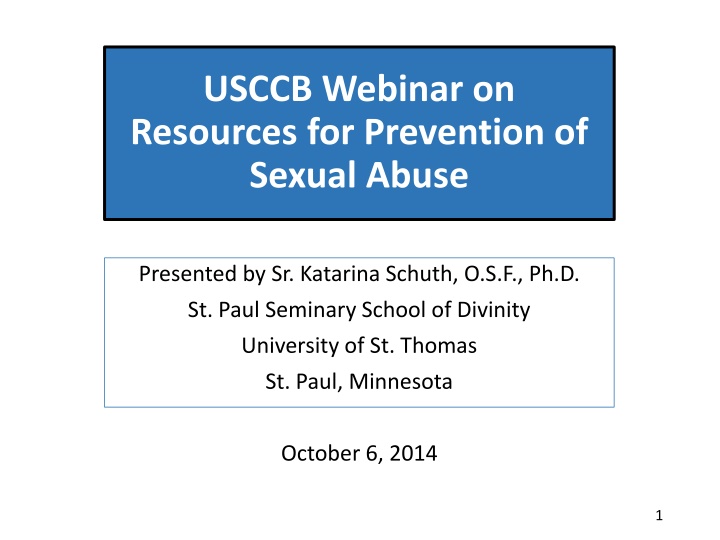
Prevention of Sexual Abuse: USCCB Webinar Insights and Resources
Explore key insights from the USCCB webinar on prevention of sexual abuse, featuring resources, data reports, and detailed modules addressing the context, causes, and responses to abuse of minors by Catholic priests in the United States. Discover methodologies, historical perspectives, and essential guidelines for dioceses, parishes, and seminaries to protect children and young people. Gain valuable knowledge presented by Sr. Katarina Schuth, O.S.F., Ph.D., and delve into the comprehensive approach to addressing this critical issue.
Download Presentation

Please find below an Image/Link to download the presentation.
The content on the website is provided AS IS for your information and personal use only. It may not be sold, licensed, or shared on other websites without obtaining consent from the author. If you encounter any issues during the download, it is possible that the publisher has removed the file from their server.
You are allowed to download the files provided on this website for personal or commercial use, subject to the condition that they are used lawfully. All files are the property of their respective owners.
The content on the website is provided AS IS for your information and personal use only. It may not be sold, licensed, or shared on other websites without obtaining consent from the author.
E N D
Presentation Transcript
USCCB Webinar on Resources for Prevention of Sexual Abuse Presented by Sr. Katarina Schuth, O.S.F., Ph.D. St. Paul Seminary School of Divinity University of St. Thomas St. Paul, Minnesota October 6, 2014 1
Main Sources of Data Reports presented to the United States Conference of Catholic Bishops by the John Jay College Research Team, The City University of New York* The Causes and Context of Sexual Abuse of Minors by Catholic Priests in the United States, 1950-2010, March, 2011 The Nature and Scope of Sexual Abuse of Minors by Catholic Priests and Deacons in the United States, 1950-2002, February 2004 * The two reports are based on data supplied by 97 percent of U.S. archdioceses and dioceses on all clergy accused of sexual abuse of minors 2
Overview of Modules Modules A through G are intended for several different audiences, with emphasis noted on each module. They include: - Dioceses and Parishes, - Seminary Faculty and Seminary Students Module J outlines Promise to Protect Pledge to Heal, the Charter for the Protection of Children and Young People, Essential Norms, and Statement of Episcopal Commitment. It is intended for all audiences. Modules K through O are intended primarily for dioceses and parishes, with emphasis noted on each module. N.B. There are no modules H and I. 3
Module A: Background and Responses to Sexual Abuse of Minors by Catholic Priests in the United States (Parishes, Dioceses, and Seminaries) A. Causes and Context of Abuse Methodology B. Timeframes and Extent of Abuse C. Development of the Five Principles D. Ongoing Concerns about Sexual Abuse 4
A. Causes and Context Methodology, 1 Analysis of clinical data from the files from three treatment centers, including information about priests who abused minors as well as those being treated for other behavioral problems (individual/psychological analysis) Analysis of seminary attendance, history and the development of a human formation curriculum, as well as information from seminary leaders (seminary analysis) Interview and primary data fromthe 1971 Loyola University study of the psychology of American Catholic priests (baseline study of priests at the peak of the abuse crisis) 5
Methodology, 2 Surveys of survivors, victim assistance coordinators and clinical files about the onset, persistence and desistance of abuse behavior (victim and situational analysis) Surveys of bishops, priests and other diocesan leaders about the policies that were put in place after 1985 (leadership analysis) Surveys of and interviews with inactive priests with allegations of abuse, and a comparison sample of priests in active parish ministry who had not been accused (identity and behavior survey) 6
B. Timeframe and Distribution of Incidences of Abuse Sources: John Jay Studies, (JJC) 1950-2002, & CARA, 2004-2008) 2000 CARA 1800 1600 JJC 1400 1200 1000 800 600 400 200 0 1954 or Earlier 1955-19591960-19641965-19691970-19741975-19791980-19841985-19891990-19941995-19992000-20022004-2008 7
The Extent of Abuse The Extent of Abuse Total credible accusations in which the date of abuse is known through 2013 16,321 Although widely believed to be a significant ongoing problem, most abuse occurred between 1960 and 1984 (74.6%); after that year the numbers dropped substantially and remain low 7.4% of abuse took place after 1990 New cases reported that occurred from 2004 to the present 2013 (1.3%) 217 Nevertheless, every case of sexual abuse is a tragedy 8
New Credible Allegations of Sexual Abuse Occurring in the Year of the Report from 2004 to 2013 Allegations Year Priests Diocesan Religious Priests Total 2013 9 1 10 2012 11 1 12 2011 21 2 23 2010 7 0 7 2009 6 0 6 (2008-13 = 58) 2008 10 3 13 2007 4 1 5 2006 14 3 17 2005 9 0 9 2004 19 1 20 (2004-07 = 64) TOTAL 110 12 122* * Besides the annual new cases, 95 others were reported from 2004 and 2013 to equal 217. Source: CARA Annual Survey of Allegations and Costs (by year of occurrence) 9
Total Credible Allegations of Sexual Abuse Reported from 2004 to 2013 Allegations Diocesan Priests Religious Priests Total Year 2013* 370 94 464 2012 397 74 471 2011 495 99 594 2010 428 77 505 2009 398 115 513 (2008-13 = 2,547) 2008 625 178 803 2007 599 92 691 2006 635 79 714 2005 695 88 783 2004 898 194 1,092 (2004-07= 4,083) TOTAL 5,540 1,090 6,630* * Includes all allegations reported for the first time in each year; all except 217 occurred before 2004. Source: CARA Annual Survey of Allegations (by year of occurrence) 10
C. Development of the Five Principles C. Development of the Five Principles 1985 1995: The issue of sexual abuse is discussed annually at meetings of the bishops; expert presentations given Leadership from Cardinal Bernardin, Archdiocese of Chicago, importance of lay review boards stressed Work of the Ad Hoc Committee resulted in publication of Restoring Trust and other changes Use of treatment continues, with extensive communication with treatment centers (surveys of treatment centers; reports to dioceses on priests referred for treatment provided) Growing advocacy for victims from organized groups of those who had been abused; included priests who had been abused Most dioceses had codified the Five Principles by mid-1990s; about 50% had review boards 11
Problems with the Implementation of the Five Principles, 1990 - 2002 Diocesan leaders in many instances failed to meet with victims directly Communication took place with civil authorities only in the most severe cases of repeated abuse Diocesan leaders who gave testimony under oath in civil cases denied the substance of the Five Principles Focus was on outcomes for priests, but lacked recognition of responsibility for harm to victims Reports from family members did not result in any follow-up from the diocese Priests were sent for treatment, then returned to service; parishes were not notified of the history of abuse 12
D. Ongoing Concerns about Sexual Abuse Sexual abuse is a dynamic issue, an ongoing problem; the harm of even one case is not to be underestimated The problem of sexual abuse has not been fixed Potential rise in abuse may be related to pornography, which is a potential predictor of abuse; it is done in privacy and more difficult to identify Objectification of the person, such as use of children in pornographic materials, is not victimless 13
Module B: Church and Seminary Responses to Sexual Abuse of Minors by Catholic Priests in the United States (Primarily for Seminaries and Also Parts for Parishes and Dioceses) A. Church Directives on Formation for Celibacy and Sexuality in Seminaries B. Phases of Reports and Responses C. Responses to Sexual Abuse by the Bishops Conference 14
A. Church Directives on Formation for Celibacy and Sexuality Pope John Paul II s Pastores dabo vobis, 1992 Introduced for the first time a section on human formation (#43), insisting that the whole work of priestly formation would be deprived of its necessary foundation if it lacked a suitable human formation The Program of Priestly Formation Guided seminaries on every aspect of preparing future priests and was issued five times by American bishops between 1971 and 2005 15
B. Phases of Reports and Responses Phase 1 1940s to Mid-1970s Early reports of a few incidents; clergy sexual abuse considered an anomaly; little response Phase 2 Mid-1970s to 1985 Still limited reports of incidents; little official response; seminaries developed some programmatic elements on celibacy and sexuality Phase 3 1985 to 2002 More reports of clergy sexual misconduct came to light, with some response by bishops, more response by seminaries Phase 4 After 2002 Revelations Outpouring of reports of clergy sexual abuse resulted in extensive response by both church officials and seminaries 16
C. Responses by the Bishops Conference Charter for the Protection of Children and Young People Developed from work of the Ad Hoc Committee on Sexual Abuse, entitled Restoring Trust, 1994 Reports Essential Norms were approved in 2002 and were published as the second part of what is commonly called The Charter or The Dallas Charter The Charter was approved by U.S. Bishops in revised form in 2005 The Charter was revised and approved for a second time in 2011 17
Module C: Research Explaining Susceptibility and Possible Causes of Sexual Abuse of Minors by Catholic Priests (For Seminaries, Parishes, and Dioceses) A. Susceptibility and Possible Causes of Abuse B. Behavioral Explanations Intimacy Deficits C. Some Controversial Findings in the John Jay Report D. Some Key Findings of the Report 18
A. Susceptibility and Possible Causes of Abuse Before examining factors that relate to sexual abuse, it is important to note that no single cause of sexual abuse of minors in the Catholic Church has been identified as a result of the John Jay research, nor is there a single cause in the general population However, it is critical to understand, for individual priests who abused minors, many organizational, psychological, and situational factors contributed to their susceptibility to perpetrate abuse 19
Progression of Risk Factors Related to Abuse Early Factors Victim of sexual abuse as a child or young adult Early sexual experience Low self-esteem and social isolation Formational Factors Intimacy deficits and lack of healthy emotional relationships Confused sexual identity Theological misunderstandings Situational Factors Inappropriate relief from stress, such as alcohol abuse Loss of support structures during times of transition 20
B. Behavioral Explanations Clinicians and behavioral theorists observe the following impacts of childhood experience and learned behavior on adult lives If a youth or child is a victim of sexual abuse by an adult, his capacity for emotional attachment and sexual response as an adult may be impaired Early sexual experience is thought to have an influence on subsequent sexual behavior Low self-esteem and social isolation are considered to be associated with child sexual abuse 21
Intimacy Deficits in Priests Accused of Sexual Abuse of Minors Intimacy deficits are weaknesses or difficulties in developing healthy emotional relationships with others Intimacy deficits increase susceptibility to deviant sexual behavior, due in part to lack of openness and honesty in relationships with mentors and peers In cohorts of priests ordained between 1940 and 1960, intimacy deficits were pronounced and sexual abuse of minors was most numerous 22
Other Factors: Stress and Abuse Transition from seminary to parish life may induce high levels of stress in some priests These situational stressors can lead to higher levels of susceptibility to abuse, and though they do not cause abuse, they may serve as triggers These stressors also may lead to reactive behavior to relieve stress, such as high levels of alcohol use, which could in turn act to decrease inhibitions that allow abuse to occur 23
Theological Misunderstanding and Sexual Abuse Priest-abusers managed their identity in relation to acts of abuse by using the image of sinner-self Their understanding of their fallibility (sinfulness) and the possibility of forgiveness in confession mean that, having received the Sacrament of Reconciliation, their relationship with God was restored, without reference to victims Often related to intense narcissism, only many years after the acts of abuse took place, did they come to understand the impact of their behavior on victims 24
C. Some Controversial Findings in the John Jay Report Celibacy and Sexual Abuse of Minors Homosexuality and Sexual Abuse of Minors Sexual Abuse by Age and Gender Social Influences on Sexual Behavior 25
Celibacy and Sexual Abuse of Minors Given the continuous requirement of priestly celibacy over a long period of time, it is not clear why the commitment to celibate chastity should be seen as a cause for the steady rise in incidence of sexual abuse between 1950 and 1980 This view is supported by the statistical observation that the vast majority of incidences of sexual abuse of children are committed by men who are not celibates 26
Homosexuality and Sexual Abuse of Minors Homosexual orientation alone is not a significant predictor of sexual abuse of minors, a finding consistent with academic research Sexual abuse by individual priests was often varied victims included both genders, and adults and youth of various ages Sexual experience heterosexual or homosexual before ordination predicts sexual misconduct after ordination, but with adults not minors Those who hold that homosexuality has a greater role in determining susceptibility to sexual abuse of minors maintain that the relatively high proportion of male victims (81%) implies that conclusion 27
Sexual Abuse by Age and Gender Overall gender and age distribution of victims *Age - Under age 7 = 6 percent 8 to 10 = 16 percent 11 to 14 = 51 percent 15 to 17 = 27 percent *Gender - Males = 81 percent Females = 19 percent *Based on the Nature and Scope data Pedophilia is a clinical diagnosis characterized by sexual attraction to prepubescent children Ephebophilia is defined as sexual attraction to pubescent or postpubescent children. Clinical diagnoses categorize the type of sexual abuse according to behaviors and not merely according to age. The percentage of priests who are identified as pedophiles is disputed by those who say that it should be higher than reported in Causes and Contexts. This view differs because of the definition being based only on age, often as high as 14. 28
Social Influences on Sexual Behavior Norms of sexual behavior were changed in the 1960s, for example The representation of sexuality was contested and the depiction of sexuality became more graphic Sexual behavior among young people became more open and diverse These and other social changes can be understood as a new valuation of the individual person and fostered the exploration and pursuit of individual happiness and satisfaction, sometimes in the form of what we now understand as sexual abuse 29
D. Some Key Findings No single cause of sexual abuse of minors by Catholic priests has been identified; however: Priests with intimacy deficits and an absence of close personal relationships before and during seminary were more likely to abuse minors Low self-esteem and social isolation are associated with child sexual abuse Abusive priests created opportunities to be alone with minors and often integrated themselves into the family, then arranged to be alone with a child Organizational, psychological, and situational factors contributed to their susceptibility to abuse 30
Module D: Situational and Organizational Factors Related to Sexual Abuse of Minors by Catholic Priests (For Seminary Students and Faculty, Parishes and Dioceses) A. Settings Where Victims First Met Priests Who Abused Them B. Physical Locations of Abuse C. Circumstances/Timing of Abuse D. Priest s Primary Duty or Role at Time of Abuse 31
A. Settings Where Victims First Met Priests Who Abused Them Location of First Meeting % Male Victims % Female Victims A. Church/Parish Related 64.8 58.9 B. School/Teacher 15.1 13.6 C. Home of Victim or Relative of Victim 4.9 14.2 D. Other Institutions 7.8 7.3 E. Other 7.1 6.2 Total 99.7 100.2 * % Based on Nature and Scope and victim survey of 7,142 boys and 1,762 girls. 32
B. Physical Locations of Abuse Location of Abuse % Male Victims % Female Victims A. Church/Parish Related 65.8 62.7 B. Residences 59.0 47.0 C. Other Locations 30.5 25.4 Note well: Clergy sexual abuse occurs in multiple settings Most frequently it is in church-related locations A wide range of residential contexts are used Other public and private venues also are exploited 33
C. Circumstances/Timing of Abuse Circumstances/Timing % Male Victims % Female Victims A. Church/Parish Related 27.1 27.8 B. Social Event/Other Recreation 42.2 40.8 C. Other 14.4 16.2 Total 83.7 84.8 * Categories are not mutually exclusive, as victims may have experienced abuse in more than one location. 34
D. Priests Primary Duty or Role at Time of Abuse Duty or Role % Male Victims % Female Victims A. Pastoral/Parish Related 77.2 80.2 B. Other Clerical Role 6.7 5.6 C. School/Teaching Role 8.7 5.6 D. Other 7.4 8.6 Total 100.0 100.0 * Based on Nature and Scope victim surveys of 7,864 boys and 1,863 girls. 35
Additional Observations Related to Situational and Organizational Circumstances, 1 To prevent or identify abuse, education of potential victims, potential abusers, and potential guardians is essential since abuse can occur when these three factors exist: a person who is motivated to commit the act of abuse a potential victim lack of a capable guardian A capable guardian is one who has oversight and awareness of a child s wellbeing, most often parents 36
Additional Observations Related to Situational and Organizational Circumstances, 2 Precautions to lessen conditions for sexual abuse to occur during meetings with children: Do not meet alone with a child in a closed room without windows Have two adults present when meeting a child whenever possible Have cameras installed in rooms where meetings take place Keep in mind: An abuser is likely to be considered a very good person Many priests who were accused of sexual abuse were in other ways excellent in carrying out their ministry 37
Module E: Typologies of Child Sexual Abusers (Primarily for Dioceses and Seminary Formation Faculty and Administrators) Typologies of Child Sexual Abusers in General and Clergy Sexual Abusers in Particular A. Fixated Typology B. Regressed Typology C. *FBI Typologies of Situational Offenders D. *FBI Typologies of Preferential Offenders E. Personality Characteristics of Clergy Offenders *For details on FBI Typologies, see complete Module E 38
A. Fixated Offenders: Definition From adolescence onward, fixated offenders have persistent, continual, and compulsive attraction exclusively to children They are usually diagnosed with pedophilia, (recurrent, intense, sexually arousing fantasies of at least six months in duration involving prepubescent children), or show characteristics of ephebophilia, which is attraction to adolescents 39
B. Regressed Offenders: Definition Regressed offenders often begin offending in adulthood Their offenses are triggered by stressors in the environment, which undermine self-esteem and confidence, and from disordered childhood relationships They are not necessarily motivated by sexual needs alone Some 90 to 95% of child sexual abusers do not have a diagnosis of pedophilia and fit within a regressed typology 40
E. Personality Characteristics of Clergy Offenders, 1 Some researchers have concluded that clergy offenders are unique compared to offenders within the general population One review of literature maintained that clergy offenders displayed shyness, loneliness, and passivity MMPI scores illustrated the presence of depression, authority concerns, and addiction problems Rorschach results indicated greater affect constriction than normal Offending clergy exhibited the presence of over- controlled hostility more than non-offending clergy 41
Personality Characteristics of Clergy Offenders, 2 One of the specific clergy studies found that offenders came from backgrounds: Characterized by rigidity and dysfunction with themes of abuse Had little insight into these areas Had insufficient training in the issue of transference/counter transference Had virtually no training or education concerning sexual abuse, domestic violence, addictive disease, or healthy professional boundaries, and Failed to appreciate how their history of trauma affected their professional life 42
Module F: Understanding the Sexual Victimization of Children (For Seminary Faculty and Students, Parishes and Dioceses) A. Sexual Abuse Victims B. Onset of Sexual Abuse C. Grooming Behavior D. Persistence of Abuse Excuses, Justifications, and Disavowal E. Desistance from Abuse 43
A. Sexual Abuse Victims Who Were the Minors Abused by Priests? Gender: Male = 81% Female = 19% Age: Under 10 = 22% 11 to 14 = 51% 15 to 17 = 27% 44
B. Onset of Abuse, 1: Preconditions The motivation to sexually abuse, for example, emotional congruence, sexual arousal, or blockage to normal sexual relationships The ability to overcome internal inhibitions The ability to overcome external factors that may prevent the abuse The ability to overcome the child s resistance to the abuse 45
Onset of Abuse, 2: Relevant Factors for Priests Priest-abusers were likely to have experienced some of the following: Poor relationships with their parents when they were youths A history of sexual abuse Isolation, loneliness, insecurity, poor social skills, lack of identity Confusion over sexual identity, psychosexual immaturity Alcohol abuse 46
C. Grooming Behavior Grooming is a pre-meditated behavior intended to manipulate a potential victim into complying with sexual abuse Examples of various tactics or methods used to entice victims: seduction or manipulation building of personal and family relationships providing benefits such as drugs, alcohol, or pornography, money, or other gifts, tickets to sporting events, or taking them on trips verbal or physical intimidation 47
D. Persistence of Abuse: Categories Mechanisms used to alleviate feelings of guilt and shame, thus enabling offenders to commit acts of abuse, are called neutralization techniques Three categories: Excuses for behavior Justifications for behavior Deviance disavowal 48
Excuses for Behavior, 1: Denial of Responsibility Accused priests denied responsibility by making claims that They were not well (using or addicted to substances such as alcohol and/or drugs) They were compelled by sick or sinful impulses Forces beyond their control allowed them to deny full responsibility for their behavior, similar to legal claims of diminished capacity 49
Excuses for Behavior, 2: Denying the Victim Accused priests denied the victim his or her status by claiming that the victim participated by being seductive or precocious, or the victim did not fight back or say anything during the abuse Accused priests blamed the victim or the victim s family for setting up conditions that allowed abuse to occur by inviting him into their home, engaging him socially, and including him as part of the family 50




